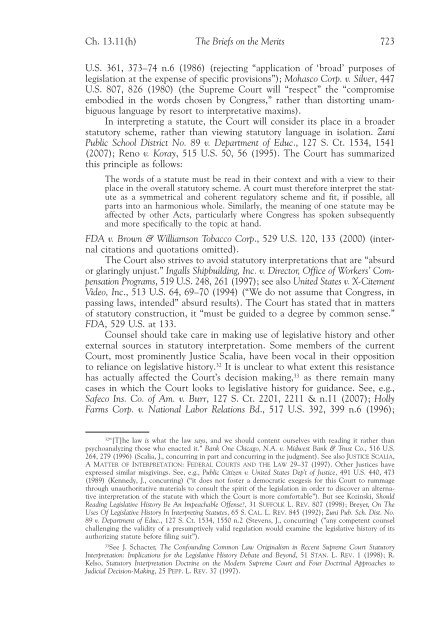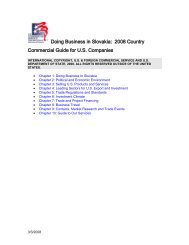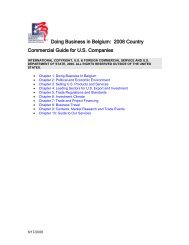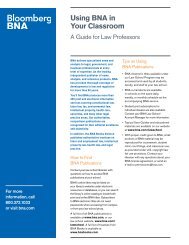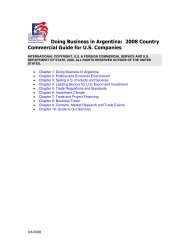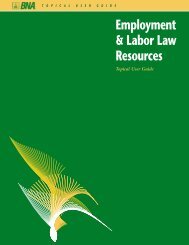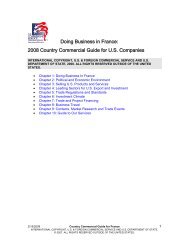Create successful ePaper yourself
Turn your PDF publications into a flip-book with our unique Google optimized e-Paper software.
Ch. 13.11(h) <str<strong>on</strong>g>The</str<strong>on</strong>g> <str<strong>on</strong>g>Briefs</str<strong>on</strong>g> <strong>on</strong> <strong>the</strong> <strong>Merits</strong> 723<br />
U.S. 361, 373–74 n.6 (1986) (rejecting “applicati<strong>on</strong> of ‘broad’ purposes of<br />
legislati<strong>on</strong> at <strong>the</strong> expense of specific provisi<strong>on</strong>s”); Mohasco Corp. v. Silver, 447<br />
U.S. 807, 826 (1980) (<strong>the</strong> Supreme Court will “respect” <strong>the</strong> “compromise<br />
embodied in <strong>the</strong> words chosen by C<strong>on</strong>gress,” ra<strong>the</strong>r than distorting unambiguous<br />
language by resort to interpretative maxims).<br />
In interpreting a statute, <strong>the</strong> Court will c<strong>on</strong>sider its place in a broader<br />
statutory scheme, ra<strong>the</strong>r than viewing statutory language in isolati<strong>on</strong>. Zuni<br />
Public School District No. 89 v. Department of Educ., 127 S. Ct. 1534, 1541<br />
(2007); Reno v. Koray, 515 U.S. 50, 56 (1995). <str<strong>on</strong>g>The</str<strong>on</strong>g> Court has summarized<br />
this principle as follows:<br />
<str<strong>on</strong>g>The</str<strong>on</strong>g> words of a statute must be read in <strong>the</strong>ir c<strong>on</strong>text and with a view to <strong>the</strong>ir<br />
place in <strong>the</strong> overall statutory scheme. A court must <strong>the</strong>refore interpret <strong>the</strong> statute<br />
as a symmetrical and coherent regulatory scheme and fit, if possible, all<br />
parts into an harm<strong>on</strong>ious whole. Similarly, <strong>the</strong> meaning of <strong>on</strong>e statute may be<br />
affected by o<strong>the</strong>r Acts, particularly where C<strong>on</strong>gress has spoken subsequently<br />
and more specifically to <strong>the</strong> topic at hand.<br />
FDA v. Brown & Williams<strong>on</strong> Tobacco Corp., 529 U.S. 120, 133 (2000) (internal<br />
citati<strong>on</strong>s and quotati<strong>on</strong>s omitted).<br />
<str<strong>on</strong>g>The</str<strong>on</strong>g> Court also strives to avoid statutory interpretati<strong>on</strong>s that are “absurd<br />
or glaringly unjust.” Ingalls Shipbuilding, Inc. v. Director, Office of Workers’ Compensati<strong>on</strong><br />
Programs, 519 U.S. 248, 261 (1997); see also United States v. X-Citement<br />
Video, Inc., 513 U.S. 64, 69–70 (1994) (“We do not assume that C<strong>on</strong>gress, in<br />
passing laws, intended” absurd results). <str<strong>on</strong>g>The</str<strong>on</strong>g> Court has stated that in matters<br />
of statutory c<strong>on</strong>structi<strong>on</strong>, it “must be guided to a degree by comm<strong>on</strong> sense.”<br />
FDA, 529 U.S. at 133.<br />
Counsel should take care in making use of legislative history and o<strong>the</strong>r<br />
external sources in statutory interpretati<strong>on</strong>. Some members of <strong>the</strong> current<br />
Court, most prominently Justice Scalia, have been vocal in <strong>the</strong>ir oppositi<strong>on</strong><br />
to reliance <strong>on</strong> legislative history. 32 It is unclear to what extent this resistance<br />
has actually affected <strong>the</strong> Court’s decisi<strong>on</strong> making, 33 as <strong>the</strong>re remain many<br />
cases in which <strong>the</strong> Court looks to legislative history for guidance. See, e.g.,<br />
Safeco Ins. Co. of Am. v. Burr, 127 S. Ct. 2201, 2211 & n.11 (2007); Holly<br />
Farms Corp. v. Nati<strong>on</strong>al Labor Relati<strong>on</strong>s Bd., 517 U.S. 392, 399 n.6 (1996);<br />
32 “[T]he law is what <strong>the</strong> law says, and we should c<strong>on</strong>tent ourselves with reading it ra<strong>the</strong>r than<br />
psychoanalyzing those who enacted it.” Bank One Chicago, N.A. v. Midwest Bank & Trust Co., 516 U.S.<br />
264, 279 (1996) (Scalia, J., c<strong>on</strong>curring in part and c<strong>on</strong>curring in <strong>the</strong> judgment). See also JUSTICE SCALIA,<br />
A MATTER OF INTERPRETATION: FEDERAL COURTS AND THE LAW 29–37 (1997). O<strong>the</strong>r Justices have<br />
expressed similar misgivings. See, e.g., Public Citizen v. United States Dep’t of Justice, 491 U.S. 440, 473<br />
(1989) (Kennedy, J., c<strong>on</strong>curring) (“it does not foster a democratic exegesis for this Court to rummage<br />
through unauthoritative materials to c<strong>on</strong>sult <strong>the</strong> spirit of <strong>the</strong> legislati<strong>on</strong> in order to discover an alternative<br />
interpretati<strong>on</strong> of <strong>the</strong> statute with which <strong>the</strong> Court is more comfortable”). But see Kozinski, Should<br />
Reading Legislative History Be An Impeachable Offense?, 31 SUFFOLK L. REV. 807 (1998); Breyer, On <str<strong>on</strong>g>The</str<strong>on</strong>g><br />
Uses Of Legislative History In Interpreting Statutes, 65 S. CAL. L. REV. 845 (1992); Zuni Pub. Sch. Dist. No.<br />
89 v. Department of Educ., 127 S. Ct. 1534, 1550 n.2 (Stevens, J., c<strong>on</strong>curring) (”any competent counsel<br />
challenging <strong>the</strong> validity of a presumptively valid regulati<strong>on</strong> would examine <strong>the</strong> legislative history of its<br />
authorizing statute before filing suit”).<br />
33See J. Schacter, <str<strong>on</strong>g>The</str<strong>on</strong>g> C<strong>on</strong>founding Comm<strong>on</strong> Law Originalism in Recent Supreme Court Statutory<br />
Interpretati<strong>on</strong>: Implicati<strong>on</strong>s for <strong>the</strong> Legislative History Debate and Bey<strong>on</strong>d, 51 STAN. L. REV. 1 (1998); R.<br />
Kelso, Statutory Interpretati<strong>on</strong> Doctrine <strong>on</strong> <strong>the</strong> Modern Supreme Court and Four Doctrinal Approaches to<br />
Judicial Decisi<strong>on</strong>-Making, 25 PEPP. L. REV. 37 (1997).


